2007 Hyundai H-1 (Grand Starex) Engine
[x] Cancel search: EnginePage 253 of 284
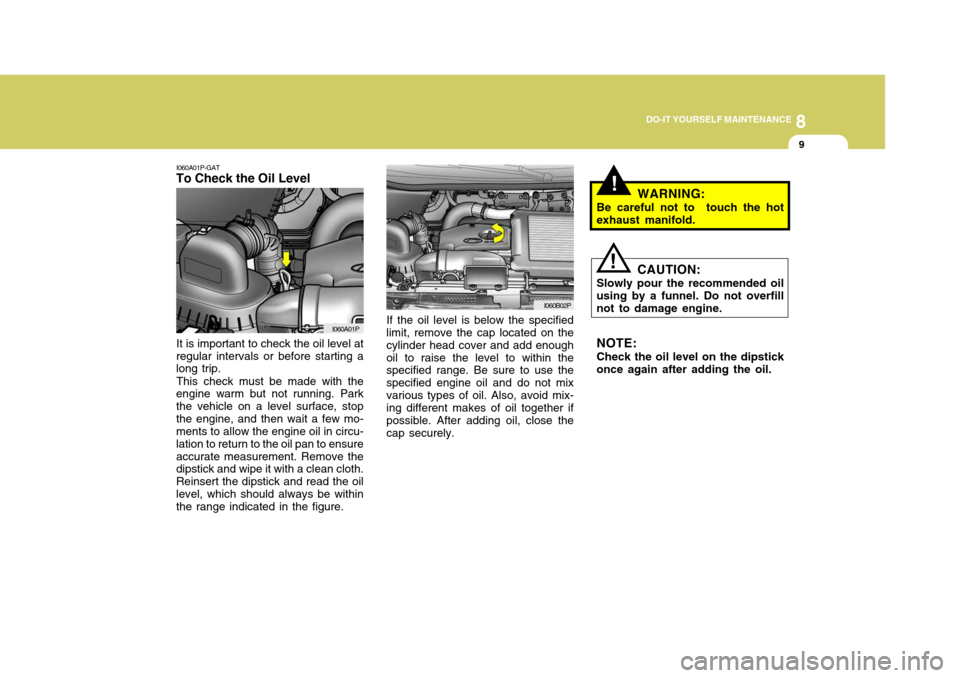
8
DO-IT YOURSELF MAINTENANCE
9
!
I060A01P-GAT
To Check the Oil Level
If the oil level is below the specified limit, remove the cap located on the cylinder head cover and add enoughoil to raise the level to within the specified range. Be sure to use the specified engine oil and do not mixvarious types of oil. Also, avoid mix- ing different makes of oil together if possible. After adding oil, close thecap securely.
It is important to check the oil level at
regular intervals or before starting a long trip.
This check must be made with the
engine warm but not running. Park the vehicle on a level surface, stopthe engine, and then wait a few mo- ments to allow the engine oil in circu- lation to return to the oil pan to ensureaccurate measurement. Remove the dipstick and wipe it with a clean cloth. Reinsert the dipstick and read the oillevel, which should always be within the range indicated in the figure. WARNING:
Be careful not to touch the hot exhaust manifold.
CAUTION:
Slowly pour the recommended oilusing by a funnel. Do not overfillnot to damage engine. NOTE: Check the oil level on the dipstick once again after adding the oil.
!
I060A01P I060B02P
Page 254 of 284

8DO-IT YOURSELF MAINTENANCE
10CHECKING THE ENGINE COOLANT
G350A01A-GAT ENGINE OIL CONSUMPTION Function of Engine Oil Engine oil has the primary function of lubricating and cooling the inside of the engine. Engine oil consumption It is normal that an engine should consume some engine oil while nor- mal driving. The cause of oil con- sumption in a normal engine are asfollows;
o Engine oil is used to lubricate pis-
tons, piston rings and cylinders. A thin film of oil is left on the cylinder wall when a piston moves downwards in the cylinder. High negative pressure generated dur-ing engine operation sucks some of the oil into the combustion cham- ber.This oil with some oil of the cylin-der wall is burned by the high tem-perature combustion gases during the combustion process. o The engine oil consumption is
strongly effected by the viscosity and quality of oil, engine rpm and driving condition etc. The engine oil is more consumed under severedriving conditions such as high speeds and frequent acceleration and deceleration than normal driv-ing condition. I080A02P-GAT
!WARNING:
Do not remove the radiator cap
when the engine is hot. When the engine is hot, the engine coolant is under pressure and may erupt through the opening if the cap isremoved. You could be seriously burned if you do not observe this precaution. Do not remove theradiator cap until the radiator is cool to the touch.
I080A01P
Page 255 of 284
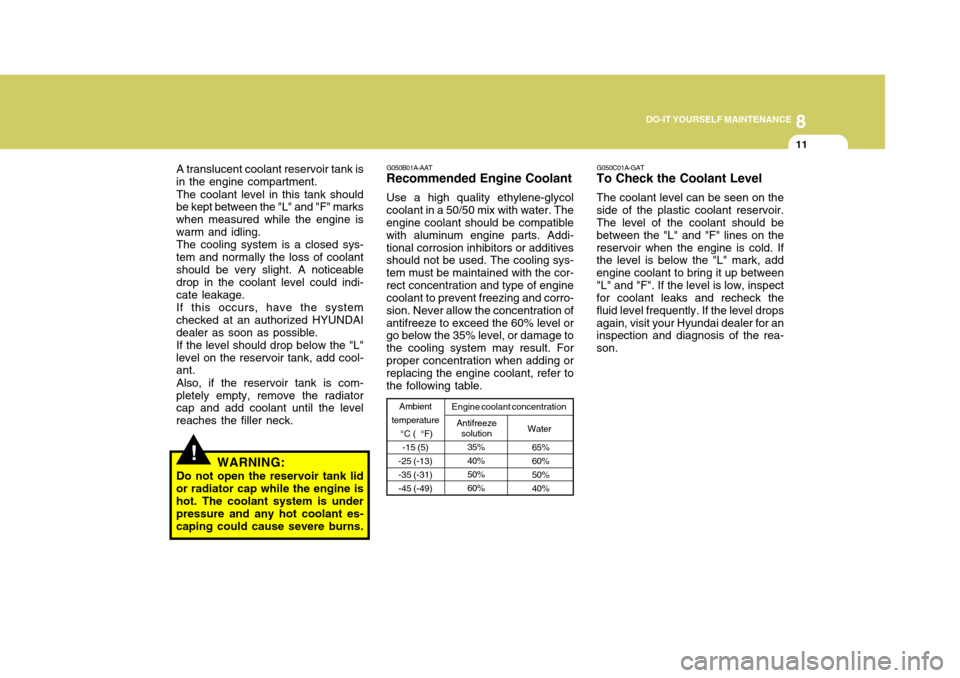
8
DO-IT YOURSELF MAINTENANCE
11
A translucent coolant reservoir tank is
in the engine compartment.
The coolant level in this tank should
be kept between the "L" and "F" marks when measured while the engine iswarm and idling.
The cooling system is a closed sys-
tem and normally the loss of coolant should be very slight. A noticeable drop in the coolant level could indi-cate leakage. If this occurs, have the system
checked at an authorized HYUNDAIdealer as soon as possible. If the level should drop below the "L"
level on the reservoir tank, add cool- ant.
Also, if the reservoir tank is com-
pletely empty, remove the radiatorcap and add coolant until the level reaches the filler neck.
!WARNING:
Do not open the reservoir tank lid
or radiator cap while the engine is hot. The coolant system is under pressure and any hot coolant es-caping could cause severe burns. G050B01A-AAT Recommended Engine Coolant Use a high quality ethylene-glycol coolant in a 50/50 mix with water. The engine coolant should be compatible with aluminum engine parts. Addi-tional corrosion inhibitors or additives should not be used. The cooling sys- tem must be maintained with the cor-rect concentration and type of engine coolant to prevent freezing and corro- sion. Never allow the concentration ofantifreeze to exceed the 60% level or go below the 35% level, or damage to the cooling system may result. Forproper concentration when adding or replacing the engine coolant, refer to the following table.
Water
65% 60%50%40%
35%40%50%60%
Ambient
temperature °C ( °F)-15 (5)
-25 (-13) -35 (-31)-45 (-49) Engine coolant concentration
Antifreezesolution G050C01A-GAT To Check the Coolant Level The coolant level can be seen on the side of the plastic coolant reservoir. The level of the coolant should be between the "L" and "F" lines on thereservoir when the engine is cold. If the level is below the "L" mark, add engine coolant to bring it up between"L" and "F". If the level is low, inspect for coolant leaks and recheck the fluid level frequently. If the level dropsagain, visit your Hyundai dealer for an inspection and diagnosis of the rea- son.
Page 256 of 284

8DO-IT YOURSELF MAINTENANCE
12
!
4. Turn the radiator cap counterclock-
wise without pressing down on it, until it stops. This relieves any pres- sure remaining in the cooling sys- tem. And remove the radiator capby pushing down and turning coun- terclockwise. Now fill the radiator with clean dem- ineralized or distilled water. Con- tinue to add clean demineralized or distilled water in small quantitiesuntil the fluid level stays up in the radiator neck.
5. Start the engine, top off the radia- tor with water and then add engine coolant to the reservoir until thelevel is between "L" and "F".
6. Replace the radiator and reservoir caps and check to be sure thedrain cocks are fully closed and not leaking. WARNING:
The cooling fan is controlled by
engine coolant temperature andmay sometimes operate even when the engine is not running. Useextreme caution when working near the blades of the cooling fan so that you are not injured by a rotat-ing fan blade. As the engine cool- ant temperature decreases, the fan will automatically shut off. This isa normal condition.
G050D02P-AAT To Change the Coolant The coolant should be changed at those intervals specified in the ve- hicle maintenance schedule in Sec- tion 6.
!
CAUTION:
Engine coolant can damage the finish of your car. If you spill en-gine coolant on the car, wash it off thoroughly with clean water.
1. Park the car on level ground, set the parking brake and remove the radia- tor cap when cool.
2. Be sure your drain receptacle is in
place. Open the drain cock on theradiator. Allow all the engine cool- ant to drain from the cooling sys- tem, then securely close the draincock.
3. Check Section 9 for the capacity of the cooling system in your car.Then, following the manufacturer's directions on the engine coolant container, add the appropriatequantity of coolant to the radiator.
Page 257 of 284

8
DO-IT YOURSELF MAINTENANCE
13
D010B02P
CHECKING THE BATTERY
!
G210A01A-AAT
WARNING:
Batteries can be dangerous! When working with batteries, carefully observe the following precautionsto avoid serious injuries. The fluid in the battery contains a
strong solution of sulfuric acid, which is poisonous and highly corrosive. Becareful not to spill it on yourself or the car. If you do spill battery fluid on yourself, immediately do the follow-ing: o If battery fluid is on your skin, flush
the affected areas with water for atleast 15 minutes and then seek medical assistance.
o If battery fluid is in your eyes, rinse out your eyes with water and getmedical assistance as soon as possible. While you are being drivento get medical assistance, continue to rinse your eyes by using a sponge or soft cloth saturated withwater.
o If you swallow battery fluid, drink a large quantity of water or milk fol- lowed by milk of magnesia, eat a raw egg or drink vegetable oil. Getmedical assistance as soon as possible.
While batteries are being charged(either by a battery charger or by the vehicle’s alternator), they produceexplosive gases. Always observe these warnings to prevent injuries from occurring:
o Charge batteries only in a well ven- tilated area.
o Do not permit flames, sparks or smoking in the area.
o Keep children away from the area. I090C01P-GAT Disconnection and connection Never disconnect the battery while the engine is running; doing so could damage the vehicle’s electrical com- ponents. First disconnect the nega-tive terminal and then the positive terminal. When connecting the bat- tery, first connect the positive termi-nal and then the negative terminal.
CAUTION:
o Keep the terminals clean. After the battery is connected, applyterminal protection grease. Toclean the terminals, use luke- warm water.
o Never short-circuit the battery; doing so could cause it to over- heat and be damaged.
o Do not smoke or bring an open flame near the battery; doing socould ignite the explosive gasgenerated by the battery.
!
Page 259 of 284
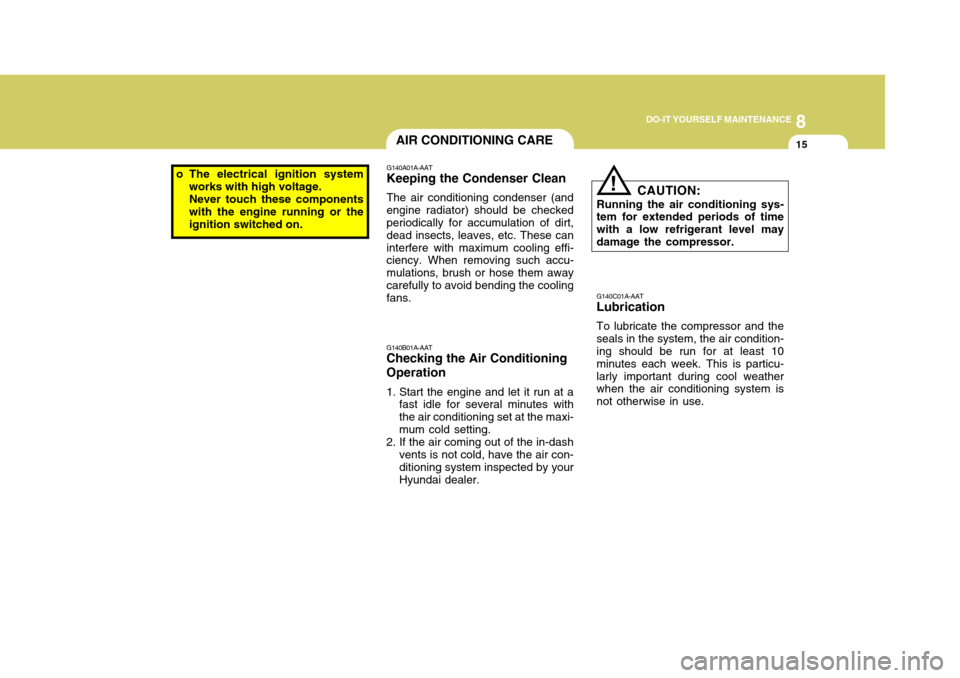
8
DO-IT YOURSELF MAINTENANCE
15AIR CONDITIONING CARE
G140A01A-AAT Keeping the Condenser Clean The air conditioning condenser (and engine radiator) should be checked periodically for accumulation of dirt, dead insects, leaves, etc. These caninterfere with maximum cooling effi- ciency. When removing such accu- mulations, brush or hose them awaycarefully to avoid bending the cooling fans.
G140B01A-AAT Checking the Air Conditioning Operation
1. Start the engine and let it run at a fast idle for several minutes with the air conditioning set at the maxi-mum cold setting.
2. If the air coming out of the in-dash
vents is not cold, have the air con-ditioning system inspected by your Hyundai dealer. G140C01A-AAT Lubrication To lubricate the compressor and the seals in the system, the air condition- ing should be run for at least 10 minutes each week. This is particu-larly important during cool weather when the air conditioning system is not otherwise in use.CAUTION:
Running the air conditioning sys- tem for extended periods of time with a low refrigerant level maydamage the compressor.
!
o The electrical ignition system
works with high voltage. Never touch these componentswith the engine running or the ignition switched on.
Page 260 of 284
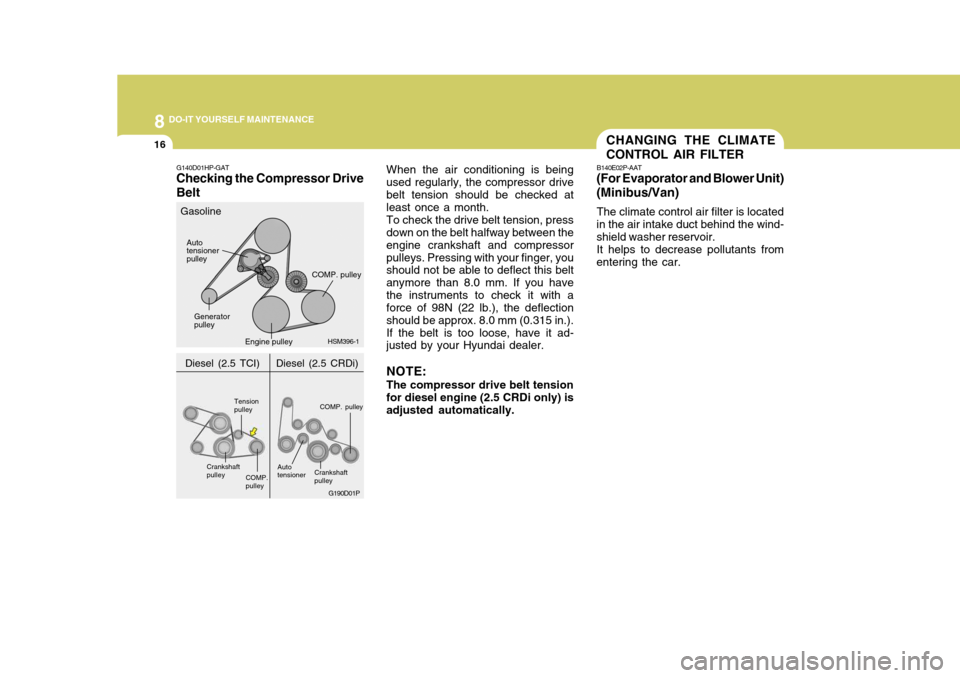
8DO-IT YOURSELF MAINTENANCE
16
G140D01HP-GAT Checking the Compressor Drive Belt When the air conditioning is being used regularly, the compressor drivebelt tension should be checked at least once a month. To check the drive belt tension, press down on the belt halfway between the engine crankshaft and compressorpulleys. Pressing with your finger, you should not be able to deflect this belt anymore than 8.0 mm. If you havethe instruments to check it with a force of 98N (22 lb.), the deflection should be approx. 8.0 mm (0.315 in.).If the belt is too loose, have it ad- justed by your Hyundai dealer. NOTE: The compressor drive belt tension for diesel engine (2.5 CRDi only) isadjusted automatically.
HSM396-1
Gasoline
CHANGING THE CLIMATE CONTROL AIR FILTER
B140E02P-AAT
(For Evaporator and Blower Unit)(Minibus/Van)
The climate control air filter is located
in the air intake duct behind the wind- shield washer reservoir.
It helps to decrease pollutants from
entering the car.
Auto tensionerpulley
COMP. pulley
Engine pulley
Generator pulley
G190D01P
Diesel (2.5 TCI)
Crankshaft pulley
COMP.pulley
Tension pulley
COMP. pulley
Autotensioner Crankshaftpulley
Diesel (2.5 CRDi)
Page 261 of 284
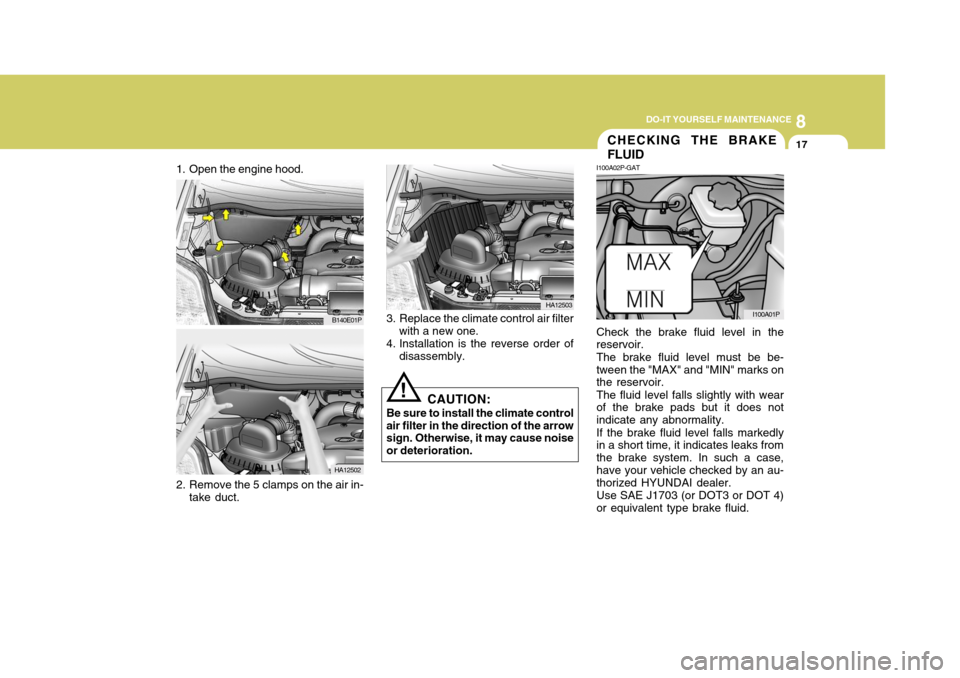
8
DO-IT YOURSELF MAINTENANCE
17CHECKING THE BRAKE FLUID
I100A02P-GAT Check the brake fluid level in the reservoir. The brake fluid level must be be- tween the "MAX" and "MIN" marks on the reservoir. The fluid level falls slightly with wear of the brake pads but it does not indicate any abnormality. If the brake fluid level falls markedly in a short time, it indicates leaks from the brake system. In such a case,have your vehicle checked by an au- thorized HYUNDAI dealer. Use SAE J1703 (or DOT3 or DOT 4) or equivalent type brake fluid.
CAUTION:
Be sure to install the climate control air filter in the direction of the arrow sign. Otherwise, it may cause noise or deterioration.
!
HA12502
2. Remove the 5 clamps on the air in- take duct. HA12503
3. Replace the climate control air filter with a new one.
4. Installation is the reverse order of disassembly. I100A01P
B140E01P
1. Open the engine hood.